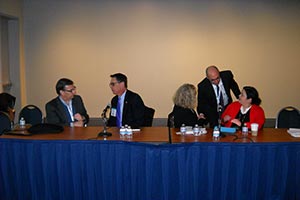Regional Planners Use Freight Capacity to Woo Business Relocation

WASHINGTON — Freight considerations are rarely of primary importance for legislators and others in government, but there are some public officials who appreciate the great importance of transporting goods and use that understanding to recruit business development.
Local and regional government planners at a Transportation Research Board session here Jan. 10 said their efforts often include 10-year projections on how to handle shipping, and that they know this information is of great importance to business executives who are considering where to locate facilities.
“Think about freight more than you have in the past,” said Chris Gutierrez, president of KC SmartPort, the economic development corporation for the 18 Kansas and Missouri counties that make up metropolitan Kansas City.
“We compete against Columbus, Ohio; Indianapolis; and Dallas,” Gutierrez said, so he pitches the four Interstate highways that pass through Kansas City (interstates 29, 35, 49 and 70), railroad connections for commodities and intermodal and the Kansas City International Airport.
BNSF Railway helped, he said, by building its Logistics Park Kansas City intermodal facility with eight cranes that can lift 1.5 million containers a year.
In Savannah, Georgia, port officials started planning for the Panama Canal expansion about 10 years before the improved canal opened in 2016, said Walter Kemmsies, chief strategist for JLL Ports Airports and Global Infrastructure.
“In Savannah, every two years they revisit their 10-year plan,” he said of the port’s management, a JLL client. Kemmsies said Savannah made for a good case study of maritime preparations.
He criticized environmental review procedures for making improvements lengthy and difficult.
“In the mid-’90s expansion plans started, but dredging didn’t start until 2016. Our system has a ridiculous amount of friction,” he said.
Port expansion is highly complex, he said, as management must coordinate channel dredging, the installation of land-based cargo cranes, container yards, highways and rail facilities.
Development of a rail shuttle to the intermodal facility in Coverdele, Georgia, about 190 miles west of the port, was particularly important, he said, as it allows CSX Transportation and Norfolk Southern to handle a torrent of shipping containers without tying up precious port real estate.
The improvements in Savannah also were noted by Dina Lopez, a planner with the Mid-Ohio Regional Planning Commission, as Savannah to Columbus is a major rail shipping lane. Lopez spoke of her work on the Ohio capital’s Rickenbacker International Airport, which mainly handles airfreight and military aircraft.
“We don’t forget freight and what it means to our regional economy,” said Lopez, who also reminded the TRB audience to consider nontransportation infrastructure — even when trying to develop transportation.




